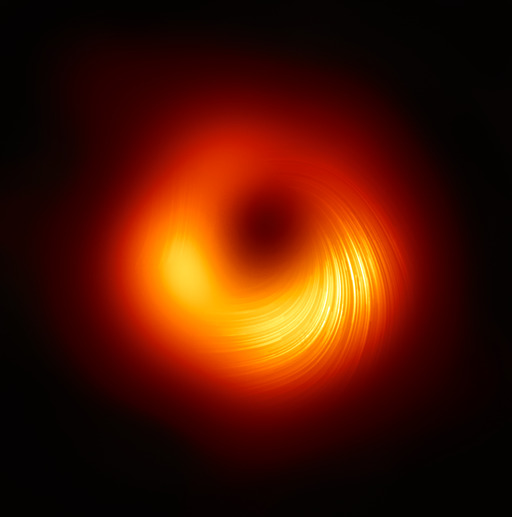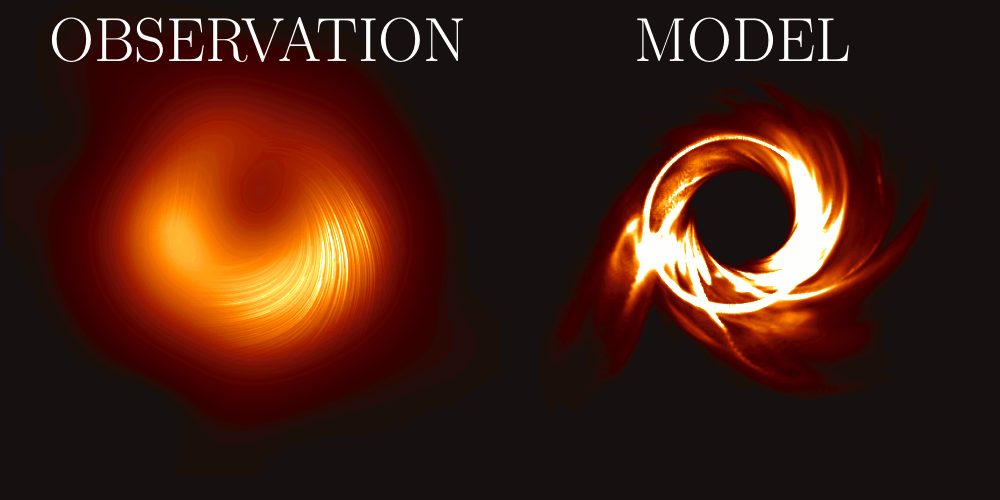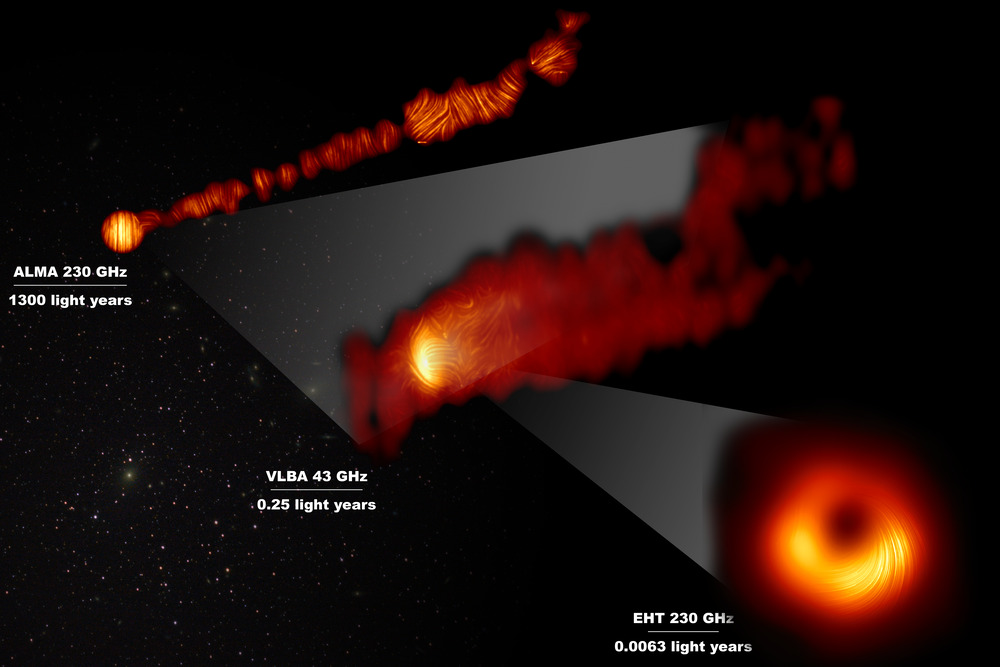The Event Horizon Telescope (EHT) collaboration, who produced the first ever image of a black hole, has revealed today a new view of the massive object at the centre of the M87 galaxy: how it looks in polarized light. This is the first time astronomers have been able to measure polarization, a signature of magnetic fields, this close to the edge of a black hole. The observations are key to explaining how the M87 galaxy, located 55 million light-years away, is able to launch energetic jets from its core.

[Figure 1] Polarized image of the black hole in M87. The lines mark the orientation of polarization, which is related to the magnetic field around the shadow of the black hole. Credit: Event Horizon Telescope Collaboration
“We are now seeing the next crucial piece of evidence to understand how magnetic fields behave around black holes, and how activity in this very compact region of space can drive powerful jets that extend far beyond the galaxy,” says Monika Mościbrodzka, Coordinator of the EHT Polarimetry Working Group and Assistant Professor at Radboud University in the Netherlands.
On 10 April 2019, scientists released the first ever image of a black hole, revealing a bright ring-like structure with a dark central region — the black hole’s shadow. Since then, the EHT collaboration has delved deeper into the data on the supermassive object at the heart of the M87 galaxy collected in 2017. They have detected a significant signal of light polarization from the region around the M87 black hole.
"Information of the magnetic field, which is one of the most fundamental information in astrophysics, can be obtained from the polarization of light. This result disclosed the structure of the magnetic field at extreme circumstances close to the black hole," says Mahito Sasada, an EHT collaboration member and Special Appointment Assistant Professor of Hiroshima Astrophysical Science Center, Hiroshima University.
Light becomes polarized when it goes through certain filters, like the lenses of polarized sunglasses, or when it is emitted in hot regions of space that are magnetised. In the same way polarized sunglasses help us see better by reducing reflections and glare from bright surfaces, astronomers can sharpen their vision of the region around the black hole by looking at how the light originating from there is polarized. Specifically, polarization allows astronomers to map the magnetic field lines present at the inner edge of the black hole.
“The newly published polarized images are key to understanding how the magnetic field allows the black hole to 'eat' matter and launch powerful jets,” says Yosuke Mizuno, Coordinator of the EHT Theoretical Models and Simulations Working Group and T.D. Lee Fellow at Tsung-Dao Lee Institute & School of Physics and Astronomy of Shanghai Jiao Tong University in China.

[Figure 2] Transition between the observed polarization image and a best-fit theory image. Credit: S. Issaoun, M. Moscibrodzka, EHT Collaboration
The bright jets of energy and matter that emerge from M87’s core and extend at least 5000 light-years from its centre are one of the galaxy’s most mysterious and energetic features. Most matter lying close to the edge of a black hole falls in. However, some of the surrounding particles escape moments before capture and are blown far out into space in the form of jets.
Astronomers have relied on different models of how matter behaves near the black hole to better understand this process. But they still don’t know exactly how jets larger than the galaxy are launched from its central region, which is as small in size as the Solar System, nor how exactly matter falls into the black hole. With the new EHT image of the black hole and its shadow in polarized light, astronomers managed for the first time to look into the region just outside the black hole where this interplay between matter flowing in and being ejected out is happening. The observations provide new information about the structure of the magnetic fields just outside the black hole. Their theoretical analysis found it most probable that spiral magnetic fields that thread the black hole become strong enough to push back on the gas against gravity’s pull, regulating the gas fall and the jet ejection.

[Figure 3] View of the M 87 supermassive black hole and jet in polarized light. This composite image shows three views of the central region of the Messier 87 (M87) galaxy in polarized light, namely, from top to bottom, with the Chile-based Atacama Large Millimeter/submillimeter Array (ALMA), the National Radio Astronomy Observatory’s Very Long Baseline Array (VLBA) in the US, and with the Earth-sized telescope synthesized by the Event Horizon Telescope. Credit: EHT Collaboration; ALMA (ESO/NAOJ/NRAO), Goddi et al.; VLBA (NRAO), Kravchenko et al.; J.C. Algaba, I. Martí-Vidal
"The observations finally confirm the innermost structure of magnetic fields that strongly support the standard model of the magnetohydrodynamic jet. We expect further investigation together with multi-wavelength radio observations including East Asian telescopes can constrain the black hole spin," says Masanori Nakamura, an EHT collaboration member and Associate Professor at the National Institute of Technology, Hachinohe College, who has been studying the M87 jet more than ten years.
To observe the heart of the M87 galaxy, the collaboration linked eight telescopes around the world, to create a virtual Earth-sized telescope, the EHT. The impressive resolution obtained with the EHT is equivalent to that needed to measure the length of a credit card on the surface of the Moon.
This allowed the team to directly observe the black hole shadow and the ring of light around it, with the new polarized-light image clearly showing that the ring is magnetised. The results are published today in two separate papers in The Astrophysical Journal Letters by the EHT collaboration. The research involved over 300 researchers from multiple organisations and universities worldwide.
"The EHT is making rapid advancements, with technological upgrades being done to the network and new observatories being added. We expect future EHT observations to reveal more accurately the magnetic field structure around the black hole and to tell us more about the physics of the hot gas in this region," concludes EHT collaboration member Jongho Park, an East Asian Core Observatories Association Fellow at the Academia Sinica, Institute of Astronomy and Astrophysics in Taipei.
More Information
The EHT collaboration involves more than 300 researchers from Africa, Asia, Europe, North and South America. The international collaboration is working to capture the most detailed black hole images ever obtained by creating a virtual Earth-sized telescope. Supported by considerable international investment, the EHT links existing telescopes using novel systems — creating a fundamentally new instrument with the highest angular resolving power that has yet been achieved.
The individual telescopes involved are: ALMA, APEX, the IRAM 30-meter Telescope, the IRAM NOEMA Observatory, the James Clerk Maxwell Telescope (JCMT), the Large Millimeter Telescope (LMT), the Submillimeter Array (SMA), the Submillimeter Telescope (SMT), the South Pole Telescope (SPT), the Kitt Peak Telescope, and the Greenland Telescope (GLT).
The EHT consortium consists of 13 stakeholder institutes: the Academia Sinica Institute of Astronomy and Astrophysics, the University of Arizona, the University of Chicago, the East Asian Observatory, Goethe-Universitaet Frankfurt, Institut de Radioastronomie Millimétrique, Large Millimeter Telescope, Max Planck Institute for Radio Astronomy, MIT Haystack Observatory, National Astronomical Observatory of Japan, Perimeter Institute for Theoretical Physics, Radboud University and the Smithsonian Astrophysical Observatory.
Paper Information
This research was presented in two papers published today in The Astrophysical Journal Letters.
Paper VII: "First M87 Event Horizon Telescope Results. VII. Polarization of the Ring", The EHT Collaboration et al., (2021), The Astrophysical Journal Letters, Vol. 910, L12
DOI: https://doi.org/10.3847/2041-8213/abe71d
Paper VIII: "First M87 Event Horizon Telescope Results. VIII. Magnetic Field Structure near The Event Horizon", The EHT Collaboration et al., (2021), The Astrophysical Journal Letters, Vol. 910, L13
DOI: https://doi.org/10.3847/2041-8213/abe4de
Related to this result, a paper of analyzing the observation data with ALMA alone is published at the same time as the above two papers.
"Polarimetric properties of Event Horizon Telescope targets from ALMA", Goddi, Martí-Vidal, Messias, et al. (EHT Collaboration; 2021), The Astrophysical Journal Letters, Vol. 910, L14
DOI: https://doi.org/10.3847/2041-8213/abee6a
Related Links
- EHT official page: Astronomers Image Magnetic Fields at the Edge of M87’s Black Hole
- YouTube (Event Horizon Telescope): "What Is Polarization"
- YouTube (Event Horizon Telescope): "How Magnetic Fields Affect Black Hole Images"
- YouTube (Event Horizon Telescope): "The M 87 image as seen with a polarizer"
